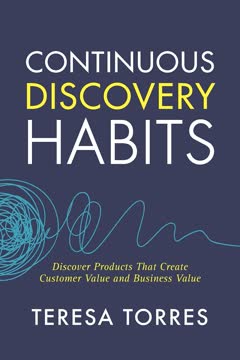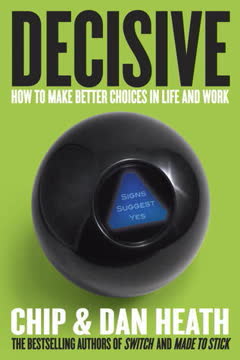Key Takeaways
1. Recognize and overcome the four villains of decision making
Our decisions are often derailed by four predictable villains: narrow framing, confirmation bias, short-term emotion, and overconfidence.
Narrow framing limits our choices by presenting decisions as binary "whether or not" options. This leads to overlooking creative alternatives. Confirmation bias causes us to seek information that supports our existing beliefs while ignoring contradictory evidence. Short-term emotion clouds our judgment and prevents clear long-term thinking. Overconfidence in our ability to predict the future makes us underestimate risks and overestimate potential gains.
To combat these villains:
- Actively look for additional options beyond the obvious choices
- Seek out information that challenges your initial assumptions
- Create distance from immediate emotions before deciding
- Consider multiple future scenarios, both positive and negative
2. Widen your options by exploring alternatives beyond the obvious
Steve Cole, the VP of research and development at HopeLab, a nonprofit that fights to improve kids' health using technology, said, "Any time in life you're tempted to think, 'Should I do this OR that?' instead, ask yourself, 'Is there a way I can do this AND that?'"
Think AND not OR. When faced with a seemingly binary choice, challenge yourself to find a creative solution that combines elements of both options. This opens up new possibilities and often leads to superior outcomes.
Techniques for widening your options:
- Use the Vanishing Options Test: Ask "What if I couldn't choose any of the current options?"
- Look for someone who's solved your problem before
- Create a "playlist" of potential solutions to common challenges
- Multitrack by pursuing multiple options simultaneously
- "Ooch" by conducting small experiments to test ideas before fully committing
3. Reality-test your assumptions through disconfirming evidence
Confirmation bias is probably the single biggest problem in business, because even the most sophisticated people get it wrong. People go out and they're collecting the data, and they don't realize they're cooking the books.
Actively seek contradictory information. Our natural tendency is to look for evidence that supports our existing beliefs. To make better decisions, deliberately search for information that challenges your assumptions.
Strategies for reality-testing:
- Ask disconfirming questions: "What problems does it have?" instead of "Do you like it?"
- Consider the opposite: Imagine reasons why your initial judgment might be wrong
- Zoom out to get base rates: Look at the average outcomes for similar situations
- Zoom in to get concrete details: Talk to people with firsthand experience
- Ooch: Run small experiments to test assumptions before making big commitments
4. Attain distance before deciding to overcome short-term emotions
Short-term emotion will often tempt you to make the wrong one.
Create psychological distance. Immediate emotions can cloud our judgment and lead to decisions we later regret. By creating mental space between ourselves and the decision, we can better align our choices with our long-term values and goals.
Techniques for attaining distance:
- Use 10/10/10: How will you feel about this decision in 10 minutes, 10 months, and 10 years?
- Ask "What would I tell my best friend to do in this situation?"
- Imagine yourself as an outside observer looking at the situation
- Consider your core priorities and how each option aligns with them
- Set tripwires to prompt reevaluation at specific points in the future
5. Prepare to be wrong by considering multiple future scenarios
Our decisions will never be perfect, but they can be better. Bolder. Wiser. The right process can steer us toward the right choice.
Plan for multiple outcomes. Overconfidence in our ability to predict the future often leads to poor planning. By considering a range of possible scenarios, both positive and negative, we can better prepare for whatever actually happens.
Methods for preparing to be wrong:
- Bookend the future: Consider both extremely positive and negative outcomes
- Conduct a premortem: Imagine the decision has failed and analyze why
- Run a preparade: Envision wild success and plan how to handle it
- Set a tripwire: Establish clear conditions that will trigger reevaluation
- Use a safety factor: Build in extra margin to account for uncertainty
6. Use a consistent decision-making process to improve outcomes
Process mattered more than analysis—by a factor of six.
Follow a structured approach. Ad hoc decision-making is prone to biases and inconsistencies. By adopting a systematic process, we can improve the quality of our decisions over time.
Key elements of an effective decision-making process:
- Widen Your Options: Generate multiple alternatives
- Reality-Test Your Assumptions: Actively seek disconfirming information
- Attain Distance Before Deciding: Overcome short-term emotions
- Prepare to Be Wrong: Consider multiple future scenarios
Benefits of a consistent process:
- Reduces the impact of cognitive biases
- Improves the quality of information considered
- Increases confidence in decisions
- Allows for continuous improvement over time
7. Trust the process, not just your gut instincts
Being decisive is itself a choice. Decisiveness is a way of behaving, not an inherited trait. It allows us to make brave and confident choices, not because we know we'll be right but because it's better to try and fail than to delay and regret.
Embrace uncertainty. While gut instincts can be valuable, they are often unreliable for complex decisions. By trusting a well-designed process, we can make better choices even in the face of uncertainty.
Advantages of trusting the process:
- Provides confidence to make bolder decisions
- Reduces anxiety and second-guessing
- Allows for faster decision-making in many cases
- Improves outcomes over time through consistent application
Remember that no process guarantees perfect results, but it can significantly increase your odds of making good decisions. The goal is to make better choices more consistently, not to achieve perfection.
</instructions>
Last updated:
FAQ
What's Decisive: How to Make Better Choices in Life and Work about?
- Focus on Decision Making: The book by Chip Heath and Dan Heath explores how to improve decision-making in both personal and professional contexts.
- Four Villains of Decision Making: It identifies four main obstacles: narrow framing, confirmation bias, short-term emotion, and overconfidence, and offers strategies to overcome them.
- WRAP Process: Introduces a structured framework—Widen Your Options, Reality-Test Your Assumptions, Attain Distance Before Deciding, and Prepare to Be Wrong—to enhance decision-making.
Why should I read Decisive by Chip Heath?
- Enhanced Decision-Making Skills: The book provides practical tools and strategies to improve your decision-making abilities.
- Research-Based Insights: It is grounded in psychological research and real-world examples, making the advice credible and relatable.
- Actionable Framework: The WRAP process offers a clear, actionable framework that can be implemented immediately to simplify complex decisions.
What are the key takeaways of Decisive?
- Widen Your Options: Avoid narrow framing by considering multiple alternatives, which encourages creative thinking.
- Reality-Test Your Assumptions: Challenge your beliefs by seeking disconfirming evidence to counteract biases.
- Attain Distance Before Deciding: Step back from immediate emotions to focus on long-term priorities.
- Prepare to Be Wrong: Anticipate potential mistakes and plan for them, fostering resilience and adaptability.
What are the best quotes from Decisive and what do they mean?
- Intuitive Feelings: “The normal state of your mind is that you have intuitive feelings and opinions about almost everything that comes your way.” This highlights the need for a structured decision-making process.
- Narrow Framing: “You encounter a choice. But narrow framing makes you miss options.” This emphasizes the importance of broadening perspectives to avoid limiting choices.
- Process Over Analysis: “Process mattered more than analysis—by a factor of six.” This suggests that how we make decisions is as important as the information we use.
What is the WRAP process in Decisive?
- Widen Your Options: Encourages exploring multiple alternatives rather than limiting choices to binary options.
- Reality-Test Your Assumptions: Involves seeking out information that challenges your beliefs and considering the opposite perspective.
- Attain Distance Before Deciding: Emphasizes stepping back from immediate emotions to consider long-term priorities.
- Prepare to Be Wrong: Involves anticipating potential mistakes and planning for them, fostering resilience.
How do I Widen My Options according to Decisive?
- Avoid Narrow Framing: Challenge yourself to think beyond binary choices to uncover better solutions.
- Vanishing Options Test: Imagine current options are unavailable and brainstorm new alternatives to encourage creative thinking.
- Seek Diverse Perspectives: Consult with others who have faced similar decisions for valuable insights.
How can I Reality-Test My Assumptions from Decisive?
- Ask Disconfirming Questions: Challenge your beliefs by seeking contrary evidence to ensure balanced decision-making.
- Consult Base Rates: Use statistical data or historical outcomes to ground your assumptions in reality.
- Engage in Constructive Disagreement: Foster an environment where differing opinions are welcomed to surface alternative viewpoints.
What is the importance of Attaining Distance Before Deciding in Decisive?
- Overcome Short-Term Emotions: Detach from immediate feelings to focus on long-term priorities and values.
- Gain Clarity: Distance provides a clearer view of the situation, enabling more objective assessments.
- Consider Future Implications: Align decisions with long-term goals for consistency with overall life direction.
How can I Prepare to Be Wrong as suggested in Decisive?
- Anticipate Mistakes: Acknowledge that errors are natural and plan for potential pitfalls.
- Set Tripwires: Establish criteria that trigger reevaluation of decisions if certain conditions arise.
- Embrace a Growth Mindset: View mistakes as learning opportunities to foster resilience and adaptability.
How does Decisive suggest overcoming short-term emotions?
- Emotional Distance: Attain emotional distance to avoid impulsive decisions based on fleeting feelings.
- Premortem Analysis: Imagine decision failure and identify reasons to anticipate pitfalls proactively.
- 10/10/10 Method: Evaluate how you will feel about a decision in 10 minutes, 10 months, and 10 years for perspective.
What is the 10/10/10 method in Decisive?
- Time Frame Evaluation: Assess how you will feel about a decision at three different time intervals: 10 minutes, 10 months, and 10 years.
- Emotional Clarity: Counteract short-term feelings by considering future emotions for a rational approach.
- Practical Application: Use this method for various life decisions, such as relationships or career moves.
How can I apply the concepts from Decisive in my life?
- Use the WRAP Process: Apply the WRAP process to current decisions by working through each step.
- Conduct Premortems: Run a premortem analysis for significant decisions to identify risks and prepare for setbacks.
- Set Tripwires: Establish criteria to reassess choices if certain conditions are met, ensuring accountability.
Review Summary
Decisive is praised as a practical guide to improving decision-making. Reviewers appreciate the WRAP framework (Widen options, Reality-test assumptions, Attain distance, Prepare to be wrong) and find the book's advice applicable to both personal and professional situations. Many readers highlight the engaging writing style and useful examples. Some critics note that certain concepts are intuitive or that the book could be more concise. Overall, reviewers recommend the book for its actionable insights and potential to enhance decision-making skills.
Similar Books










Download PDF
Download EPUB
.epub digital book format is ideal for reading ebooks on phones, tablets, and e-readers.









